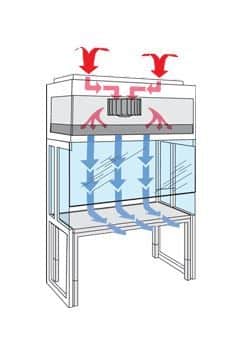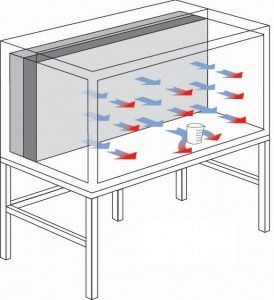
A laminar flow system is a vital concept in the control of particulate contamination. Laminar airflow is defined as air moving at the same speed and in the same direction, with no or minimal cross-over of air streams (or 'lamina'). By contrast, turbulent air flow creates swirls and eddies that deposit particles on surfaces randomly and unpredictably. Most contamination-sensitive environments such as healthcare environments or dust-free cabinets require laminar flow because it predictably sweeps particles in a uniform direction, from the cleanest area under the cabinet (the filter face) to the exit area, which is generally the sash opening or vents along the back or bottom of the cabinet. This design ensures that the cleanest (and most germ-free) area will always be the upstream area closest to the filter face. Work is generally done in that clean zone, as far as possible from obstructions that create turbulence.
But which direction should the laminar flow move: vertically (downward from a filter positioned above the work surface) or horizontally (forward from a filter positioned behind the work surface)? There are compelling reasons to choose either airflow system, depending on clearance requirements, process type/ location, work surface design and of course, operator safety. Depending on your needs, you may also need to consider
Vertical laminar flow cabinets are often chosen because they resemble, on a small scale, the design of a cleanroom, in which fan/filter units are typically positioned in the ceiling. By directing the laminar flow downward, vertical laminar flow reinforces the effect of gravity and sweeps particles out of the enclosure, generally through a front access area. Micro-contaminants may not have substantial mass, but most particles do eventually settle on a work surface or the floor of a room, and vertical flow helps get them there faster.

A clean bench using a vertical laminar flow design is also preferable where floor space is at a premium. Because this configuration stacks the fan/filter module on top of the cabinet, a vertical laminar flow cabinet can generally be installed on a standard lab bench. By contrast, a horizontal-flow cabinet requires additional depth to accommodate the rear-mount filters with some additional rear clearance to allow air to enter the system. These clearance requirements necessitate a deeper bench and more floor space than a vertical flow system.


Although both airflow designs provide effective sweeping action near the filter face, their respective flow patterns eventually encounter disruptions that often tip the scale in favour of one or the other configuration. In a vertical-flow cabinet, the obvious obstacle is the work surface. A perforated work surface allows the laminar air stream to pass through the cabinet with minimal obstruction, but these tops can be a problem in operations involving liquids or small parts. If you’re working with these materials and want to avoid picking up parts off the floor, a horizontal flow design may be preferable.
Yet even a solid top may not rule out vertical flow if work is performed above the work surface. If sterile or particle-sensitive processes are performed in a clean, sterile zone midway between the work surface and the filter face, a vertical flow cabinet is generally acceptable. One such operation is sterile compounding, in which injectables or sterile packages are prepared above, not on, the work surface. As long as hands and other contamination sources move up and down, not sideways above a sample, sensitive materials will remain clean.
Finally, consider the effects on operators of air exiting the laminar flow cabinet. Although horizontal laminar flow, with air traveling from the rear of the cabinet and exiting the front opening, may not encounter large obstructions inside the cabinet, it does eventually encounter the person performing the work. Any annoying substances, such as soldering fumes or fine powders, may be blown into the operator’s face. While this collision may not compromise the laminar flow where work is performed, it may pose a health risk. In such cases, vertical flow is probably preferable.
Some final considerations involving both vertical and horizontal laminar cabinets:
1) Neither vertical nor horizontal laminar flow cabinets are appropriate in the presence of biohazards. Only an approved containment system, such as a Class II, Type A2 Biosafety Cabinet, should be used in applications requiring Biosafety Level (BSL) 2 or 3 containment.
2) Whichever laminar flow cabinet design you choose, be sure to run it for at least 15 minutes before you begin critical operation, to allow particles to be purged from the enclosure.
3) Remember the sweeping direction, from clean to dirty, whenever you clean a cabinet. Wipe down surfaces in smooth, linear motions beginning at the filter face and moving downstream, with the air flow. Likewise, perform 'dirty' operations, like unpacking samples, as far from the filter as possible.
Are you looking for advice on the best laminar flow cabinets for your usage? Contact the team today. Alternatively, you can visit our laminar flow cabinet product page.
Read our Privacy Policy for more information on how we collect and process data.



No thank you
Read our Privacy Policy for more information on how we collect and process data.